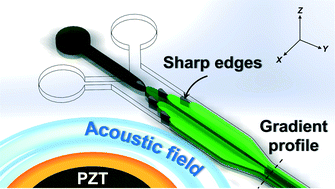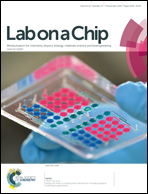A spatiotemporally controllable chemical gradient generator via acoustically oscillating sharp-edge structures†
Abstract
The ability to generate stable, spatiotemporally controllable concentration gradients is critical for resolving the dynamics of cellular response to a chemical microenvironment. Here we demonstrate an acoustofluidic gradient generator based on acoustically oscillating sharp-edge structures, which facilitates in a step-wise fashion the rapid mixing of fluids to generate tunable, dynamic chemical gradients. By controlling the driving voltage of a piezoelectric transducer, we demonstrated that the chemical gradient profiles can be conveniently altered (spatially controllable). By adjusting the actuation time of the piezoelectric transducer, moreover, we generated pulsatile chemical gradients (temporally controllable). With these two characteristics combined, we have developed a spatiotemporally controllable gradient generator. The applicability and biocompatibility of our acoustofluidic gradient generator are validated by demonstrating the migration of human dermal microvascular endothelial cells (HMVEC-d) in response to a generated vascular endothelial growth factor (VEGF) gradient, and by preserving the viability of HMVEC-d cells after long-term exposure to an acoustic field. Our device features advantages such as simple fabrication and operation, compact and biocompatible device, and generation of spatiotemporally tunable gradients.



 Please wait while we load your content...
Please wait while we load your content...